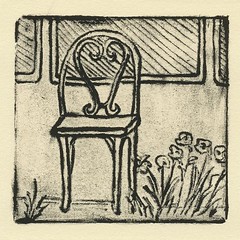This is a styrofoam print made from the top of a hamburger box. The rounded corners are on the molded box. The next time you see such a box, take a look! My mother had some little chairs like this in her patio, which I used to photograph. This chair always reminds me of her, and I have used its likeness in other art works.
The recent Paris Review features an interview with Nobelist Kenzaburo Oe, who was born the same year that I was. Listen to this: "The issue of nuclear arms was and is a fundamental question for me. Anti-nuclear activism, simply put, opposes all currently existing nuclear weaponry. On that point, it has not changed in the slightest--and neither have I as a participant in that movement. It is, in other words, a hopeless movement."
[Paris Review 183, p. 43]
In the interview he comes across as a sane and sensible and very thoughtful person, nourished by the best that has been thought and written.
"INTERVIEWER
For some of your novels, you've adopted an intellectual project—usually a poet whose work you read obsessively and integrate into the book. In Rouse Up O Young Men of the New Age! it's Blake, in Somersault it's R. S. Thomas, and in An Echo of Heaven it's Kim Chi Ha. What purpose does this serve?
OE
The ideas in my novels are fused with the ideas of the poets and philosophers I am reading at the time. This method has also enabled me to tell people about the writers I think are important.
When I was in my twenties, my mentor Kazuo Watanabe told me that because I was not going to be a teacher or a professor of literature, I would need to study by myself. I have two cycles: a five-year rotation, which centers on a specific writer or thinker; and a three-year rotation on a particular theme. I have been doing that since I was twenty-five. I have had more than a dozen of the three-year periods. When I am working on a single theme, I often spend from morning to evening reading. I read everything written by that writer and all of the scholarship on that writer's work.
If I am reading something in another language, say Eliot's Four Quartets, I spend the first three months reading a section such as "East Coker" over and over again in English until I have it memorized. Then I find a good translation in Japanese and memorize that. Then I go back and forth between the two—the original in English and the Japanese translation—until I feel I am in a spiral that consists of the English text, the Japanese text, and myself. From there Eliot emerges." [Paris Review 183, p.47]
This has to, and does, make me ashamed of my work on the this blog this week. If I once miss a day, it seems so easy to skip the next one and so it goes. I have given up trying to make the picture and the text have an obvious relation. Sometimes this makes for very interesting juxtaposions, and sometimes it just makes for head scratching. . .
This man, Kenzaburo Oe's, life and thought are truly inspiring. Check him out!

No comments:
Post a Comment